The American Art Therapy Association’s (AATA) 55th annual conference, “Building Bridges,” was held in Pittsburgh, Pennsylvania from October 5th to October 9th, 2024. This year, Florida State University’s Art Therapy faculty, students, and alumni were involved in approximately 25 papers, panels, and workshops. Over the duration of the AATA conference, the four art therapy faculty members, Dr. David Gussak, Dr. Barbara Parker-Bell, Dr. Nancy Gerber, and Dr. Karina Donald–presented four papers, six panels, one Master’s-level supervision session, and one workshop Dr. Gussak presented one paper, three panels, and one Master’s-level supervision session.
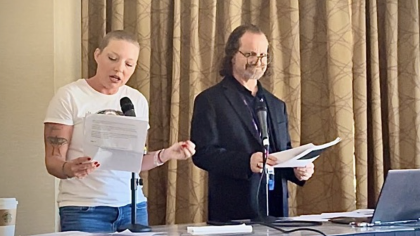
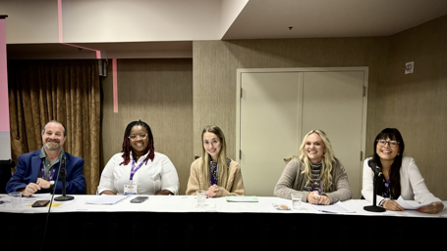
Presenting his paper, “Bridging Conflicting Ideas: Is Serial Killer Art Redemptive or Manipulative?” Dr. Gussak engaged in a dialogue with colleague and Art Therapist, Alicia Seymour that focused on the potential weaponization of art and the question of whether the art of serial killers is potentially redemptive or merely manipulative.
His participation in three panels: “Towards Generativity: Collective Musings on the Developmental Trajectory of Art Therapy,” “Art Therapy Licensure: How to Effectively Organize, Educate and Advocate,” and “When it Hits the Fan: Negotiating Prison Dynamics for Art Therapy Interns” allowed him to share his expansive knowledge of the field. On the panel for the prison dynamics panel were four FSU Art Therapy program alumni, Cheyenne Baez, Laurie Gentry, Keilana Hoffstetter, and Khalia Kennedy. Together they discussed how their practicum was structured in the prisons and how they navigated their experience through challenges and strategies.
Dr. Barbara Parker-Bell engaged in two conference presentations. Together with Courtney Robson, DTCare Ukraine project manager, and Polina Bereziuk, Maria Boiko, and Oro Whitley, DT Care supported organizers and facilitators of creative programs in Ukraine, Dr. Parker-Bell contributed to the “Building Bridges of Healing: Art Therapy Informed Crisis Care in Ukraine” panel. DTCare is a non-profit organization focused on empowering disadvantaged communities around the world. DTCare has been instrumental in developing art-therapy-informed mental health programming throughout Ukraine. During the panel, speakers highlighted the experiences of Ukrainian citizens during the war with Russia, the ongoing need for psychological assistance, and the effectiveness of art-based interventions with children, adults, and veterans. Dr. Parker-Bell described how she and other international art therapists provided training and support to Ukrainian practitioners serving those in need.
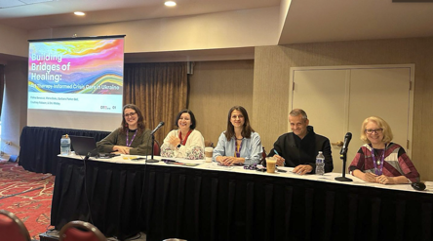
Additionally, in her workshop entitled, “Career Focused Bridge Drawings: Conceptualizing Desired Work Life Roles,” Dr. Parker-Bell and FSU Art Therapy program graduate student Kristina Smatrakaleva, demonstrated how bridge drawing prompts can be used for career exploration, goal setting, and decision-making for adolescents and adults. The workshop included a discussion of art therapy’s history of bridge drawing use, conducive media for bridge creation, time for creative engagement, and consideration of reflective questioning options designed to explore career development aims and steps.
Dr. Nancy Gerber presented one paper during the in-person conference and two panels during the virtual conference. During her in-person conference presentation on her book entitled, Imaginative and Arts-Based Practices for Integration in Research, Dr. Gerber discussed the philosophical assumptions, defining concepts, and methodological issues related to the introduction of intentional imaginative mental processes and arts-based practices into some or all phases of investigation and data integration in research.
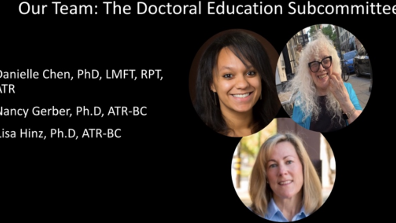
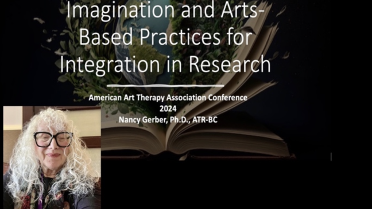
Dr. Gerber also presented at the AATA Virtual Conference from October 26th to October 27th. Her first panel entitled, “Charting the Future of Art Therapy Research: Implementation for Advancement and Sustainability” was presented alongside research colleague and former FSU faculty, Dr. Theresa Van Lith and FSU Art Therapy program alumna, Madeline Centracchio.
Her second panel was entitled, “Doctoral Education: Is it For Me?” This presentation was affiliated with the Doctoral Education Subcommittee of the American Art Therapy Association chaired by Dr. Gerber. She presented alongside distinguished colleagues and fellow subcommittee members Dr. Danielle Chen, an FSU Art Therapy program alumna, and Dr. Lisa Hinz, Director of the Art Therapy Ph.D. Program at Dominican University.
Several art therapy master’s and doctoral program alumni presented at the conference. For example, recent MS Art Therapy graduate TaNica Holmes presented a paper related to her master’s thesis at the AATA conference entitled, “Daddies Cry Too: A Cumulative Collage Exploring Fathers’ Lived Experiences of PPD.” Her thesis explored how the cumulative collaging experience for a father can lead to calm acceptance of themselves over time. Dr. Gerber served as her thesis supervisor and celebrated her accomplishments.
Dr. Karina Donald presented two papers during the conference. The first paper entitled, “Family Art Therapy in the Caribbean,” explored the intersection of art therapy and Caribbean family systems, tracing the journey from historical perspectives to contemporary understandings. During the presentation, Dr. Donald advocated for collaboration between art therapists and community leaders, the use of culturally relevant art materials, and flexibility in non-verbal interventions. In presenting the second paper entitled, “Community Art Therapy for Caribbean Youth,” Dr. Donald presented her research study which examined the impact of three community art therapy programs on Caribbean youth self-esteem and spiritual perception. The study used quantitative measures and qualitative insights to explore culturally responsive artmaking activities.
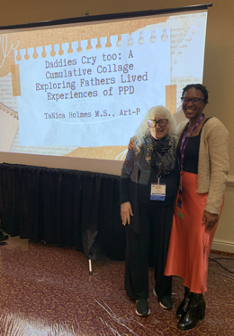
Dr. Karina Donald presented two papers during the conference. The first paper entitled, “Family Art Therapy in the Caribbean,” explored the intersection of art therapy and Caribbean family systems, tracing the journey from historical perspectives to contemporary understandings. During the presentation, Dr. Donald advocated for collaboration between art therapists and community leaders, the use of culturally relevant art materials, and flexibility in non-verbal interventions. In presenting the second paper entitled, “Community Art Therapy for Caribbean Youth,” Dr. Donald presented her research study which examined the impact of three community art therapy programs on Caribbean youth self-esteem and spiritual perception. The study used quantitative measures and qualitative insights to explore culturally responsive artmaking activities.
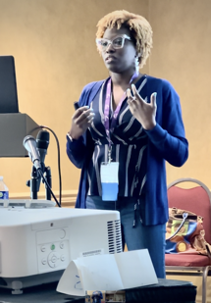
The Student Art Therapy Association (SATA) at Florida State University ran a successful booth throughout the conference where they connected with other conference attendees, provided information about the Art Therapy program and raised funds through sales of creative works.